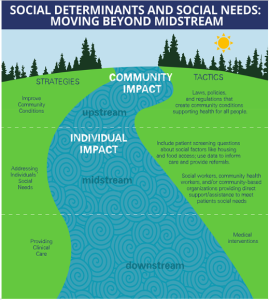At this month’s annual West Valley Heath Community Leaders Forum, I learned that the most powerful tools for moving toward health equity at the community level are voluntary guidelines issued by national, nonprofit organizations that represent different health care professions.
I know; it sounds crazy.
When I think about sustainable health improvements in regional communities, I think about laws, policies, and regulations. I think that we all do. Here’s a graphic from the 2020 forum that I think brilliantly captures the way most of us think about local change:[1]
This visual metaphor is insightful, and it helps us think about what change looks like. But from the viewpoint of the forum’s keynote speaker, Dr. Atri Alireza[2], international leader in Alzheimer research, looking to healthcare law to move Alzheimer research forward is a losing proposition.
What Dr. Alireza is really excited about as a potential game-changer for the West Valley are the new implementation strategies associated with the 2018 guidelines for Alzheimer’s best clinical practice that will be published at the 2020 Alzheimer’s Association International Conference. Clinicians are held responsible for acting in accordance with the national health guidelines issued by their governing bodies. “You are the change makers,” he told the audience comprised of mostly older adults. “Demand for yourself, and for the people you care for, the services that are included in the guidelines,” he said.
More Support for Clinical Guidelines as Pathway to Change
Dr. Alireza’s assessment was echoed even more forcefully by Dr. Catherine Alfano, international leader in cancer rehabilitation research and the American Cancer Society’s national director of survivorship. During our interview Alfano explained she is co-chair of the ASCO (American Society of Clinical Oncology) panel that will issue 2021 guidelines for oncologists on exercise, weight management, and nutrition.
“This is huge! ASCO is going to tell oncologists and the clinician community, “Hey we are your governing body. You look to us as the reference and we are saying that you need to be dealing with this, you need to be referring new patients to local venues where they can get the exercise guidance they need.[3]”
From a patient point of view, there are significant advantages to focusing on professional guidelines instead of public laws, policies, and regulations. First, clinical guidelines can be enforced directly, on an individual basis, if it becomes clear that an organization is not requiring its physicians to conform to professional guidelines of care. Second, clinical best practice guidelines are evidence-based and authored by panels of experts who stay abreast of the most recent research. Third, the experts who define the guidelines have already given some thought to useful implementation tactics. Alfano pointed out that a healthcare system might provide a local gym for patient exercise even before 2021 if it means avoiding complaints that they are providing sub-standard care.
How Does Health Change Happen
in American Communities?
Alfano’s response to this question starts in Norway. Alfano recently met with the Norwegian Minister of Health about cancer rehabilitation and exercise promotion. “He got it immediately,” she said. “He said that what he would do is drop the screening test into the official cancer care pathway of Norway,” she said. “It could be implemented in a matter of weeks.”
But things don’t work that way here. From Alfano’s perspective, “We can’t do that in the United States precisely because we are states, and not only are we states but we are healthcare systems within states, and every healthcare system makes up its own stuff. Norway can say, and the UK is already saying, that exercise is standard of care for every patient with cancer, and that’s great,” she said. “But we can’t do that here because that is not how American healthcare works.”
So how does Alfano think change happens in US healthcare? Her answer is that we make changes in the US by getting a high-profile system to be first, to make that change, and to show other systems that it works. To bring exercise to the community, the demand for exercise must be loud and urgent. A positive response from healthcare systems depends, she said, on the extent of the pressure oncologists will feel about implementing the 2021 ASCO exercise guidelines.
[1] Vitalyst Health Foundation (formerly St. Luke’s Health Foundation)
[2] Atri Alireza, MD, PhD, Director, Banner Sun Health Research Institute, Center for Brain/Mind Medicine Brigham and Women’s Hospital, and Harvard Medical School, 19 February 2020.
[3] Personal communication, 25 Jan 2020.

 Stay posted Here
Stay posted Here